
The Holbrook area is situated in the high rainfall zone (+600mm) of southern NSW, with predominantly mixed farming enterprises. The farming operations in the area include wool, lamb, beef cattle, wheat and other grains and pasture seed.
Holbrook Landcare has 3 weather stations in the area with the purpose of providing land managers with accurate, easily accessible, local data to enable more strategic management decisions on their farms. These weather stations now provide users with more accurate information on local soil water content and atmospheric conditions to assist with decisions regarding pasture management and fertilizer applications, therefore improving productivity, profitability and environmental outcomes.
Previously, weather data for the Holbrook region was gauged from information out of Albury. Now landholders have access to accurate and constant data recording, enabling current, weekly and monthly weather reports to be generated. The weather stations upload information to the HLN website every 10 minutes via a Next G modem. From a touch of a button, users can easily access information in the field or at the office. To access weather station data go to the ‘Weather Stations’ page.
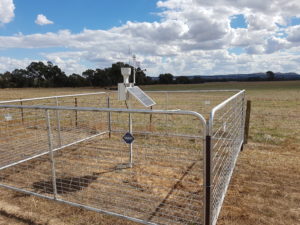
Holbrook Landcare have 4 soil moisture probes which will measure soil characteristics including soil temperature and plant available water. This information is available in real time, via the Hussat website
This data will assist land managers with decision making around livestock, pasture and cropping management; setting grazing rotations, allocating livestock feed and supplements and could also be used as a tool to make decisions on the timing of N fertiliser application, re-sowing or pasture renovation. Access of real time weather station data is available through the HLN webpage or via any device with internet connection. We encourage you to jump on the website and have a look at the information provided.
These weather stations have been funded by Holbrook Landcare Network through the continued support of its members.
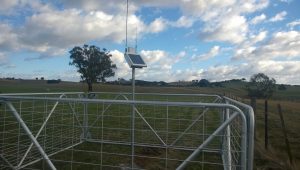
2019/2020 SmartFarms Increasing Dung Beetle Diversity and Abundance for Improved Soil Health
Holbrook Landcare has a dung beetle project starting September 2020, with 2 farm nurseries being installed with a new species of dung beetle to fill the spring gap of beetles we have in this region. The Onthophagus vacca has been introduced from Morocco, as part of the Dung Beetle Ecosystsm Engineers project. Holbrook Landcare is partnering with CSU to help with the distribution of the beetle across the region.
Thanks to this new spring active species, the dung beetle benefit could soon be felt year-round with insects burying livestock dung which in turn boosts soil nutrition, improves water permeation and can radically reduce fly and parasite numbers. To see the media update click here.
Dung beetle monitoring will begin shortly and information on what species are established in this area will be available here. If you would like further information on this project contact the HLN office. This project is supported by the Australian Governments National Landcare Program.
HLN has some of the CSIRO dung beetle glove box identification guide available in the office if you would like one.
2016 Who’s Who in the Poo
(funded by Murray LLS and the Australian Government through the National Landcare Program.)
HLN held a successful series of events looking at dung beetles on 26-27 April 2016.
- Graeme Stevenson presented on the benefits of dung beetles in the landscape.
- Belinda Pearce ran a very informative ID workshop. Belinda has quite a history of working with dung beetles in the Kiewa Valley and put together the dung beetle resource package some years ago.
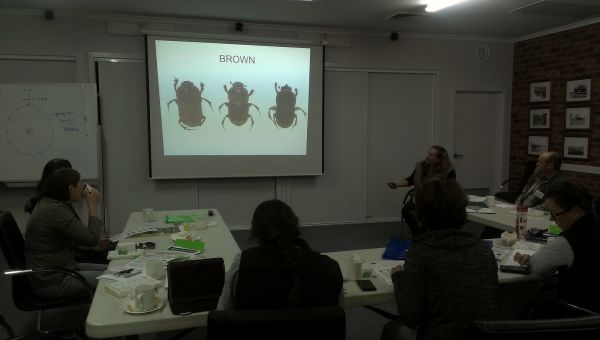
- The workshop was followed by a farm walk at ‘Blairgowrie’, where we were all very excited to find 3 active species working away in the paddock. Thanks to Dick Turnbull for hosting the farm walk.

As we know, agriculture is a dynamic, diverse and ever evolving industry. It’s also one of Australia’s most exposed industries to risks posed by climate change, changing expectations from consumers and large fluctuations in input and commodity prices, which all impact on its current and long term financial and ecological viability.
Climate variability and unpredictable weather patterns are challenging the ‘norms’ of farming in our area, and land managers are looking for ways to understand the conflicting information available on how significant changes in climate will impact their businesses and management models, the possible effect on how best to manage their soil, water, vegetation and biodiversity to meet industry goals and changing community expectations.
The Adaptive Farming Systems project provides a great opportunity for farmers to reflect on their management strategies for their production system including for meeting production goals, adapting to changing climate, dealing with severe weather events and maintaining the health of their soils and natural assets to continue to support that system.
We see a lot of discussion and debate about “regenerative” farming versus “traditional” farming. From our perspective, we don’t endorse any particular farming system.
All farmers manage – soils, pasture/crops and livestock and there are many different models to do that successfully that fit the family, the business and the landscape you farm in.
Here we are showcasing a few different farming system models and hopefully this will help people think about their own goals and landscape, and give some ideas about management for goals of financial and environmental resilience.
The project features 4 local farmers who share their management stratergies via a range of management systems. Each system considers climate variability and production sustainability.
This project has also provided an opportunity to look into Environmental Accounting and what producers need to consider before making decisions about their carbon sequestration.
Improving soil health with a focus on plants – an interview with Grant Sims and Declan McDonald.
This project has been funded by the Australian Governments National Landcare Program.
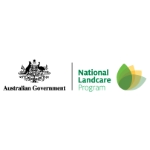
In progress
2021 Update – Greater Hume Council is now continuing to run this service . During the funded part of the project we were able to divert 50T of silage wrap from Landfill.
One of the challenges of any recycling program is creating the demand fo rthe end products. Our partner Plastic Forests has various recycled products for sale that are made from onfarm plastics. Consider supporting them next time you are buying posts, garden edging and raised garden beds!
THe link to the plastic forests website is https://plasticforests.com.au/
Bags can be picked up from any Greater Hume Council office, and cost $1 each.
2020
How to dispose of your silage wrap and twine through this program, and view the recycling process – see our video series for details.
2019
Holbrook Landcare has been successful in its funding bid through the National Landcare Program Smart Farms Small Grants. The project, “Embedding a Recycling Culture for Silage Wrap and On Farm Plastics” will continue on from where the hay and silage wrap recycling pilot project left off. Part of this project is to extend recycling availability of on farm plastics throughout the Greater Hume Shire. The grant includes funding for extra drop off points at Culcairn, Mullengandra and Burrumbuttock landfill sites.
The environmental impact of providing an alternative farm plastic waste solution for landholders is significant, as the plastic waste has previously been buried or burnt on farm. Around 28 tonnes of silage wrap and twine has already been dispatched to Plastic Forests in Albury for recycling over the last 18 months, and the uptake of participation continues to increase. We are delighted that the Greater Hume Shire is supporting this innovative recycling program, which has already generated interest from many other shires and groups across the country, including other REROC members!
Currently you can continue to drop your silage wrap and twine at the Holbrook tip, using bags provided by Holbrook Landcare. Skip bins are in place at Burrumbuttock, Culcairn and Mullengandra council tips as well. Please make sure your silage wrap and twine are separated into the bags provided by HLN, and no other plastic can be recycled by Plastic Forests in Albury. Please do not leave bunker bags, netting, feed bags, rubbish or any other material at our allocated landfill sites, this cannot be recycled!
We would like to thank Greater Hume Shire Council for their ongoing support for this project and to the National Landcare Program.
2017 – 2018
This project has been hugely successful, clearing around 12 tonnes of silage wrap and string from being burnt or buried on farm. Instead it has been delivered to a recycling plant in Albury, Plastic Forests, turning this waste into a range of recycled plastic products including underground cable cover, garden edging and resin pellets.

HLN has applied for funding to continue this project in the GHSC area. We will hear in May 2018 whether we have been successful in our bid. In the mean time you can continue to drop your silage wrap off at the Holbrook waste depot. Another skip bin is to be delivered to Plastic Forests in March/April 2018.
If you have any feedback regarding this pilot project we wold love to hear it. You can contact us on (02) 6036 3181 or [email protected].
A big thank you to the Greater Hume Shire for their support of the project and Murray LLS who has supported the project with funding from the National Landcare Programme.
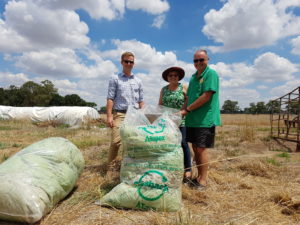
Other documents;
This tool was developed as part of the ‘Carbon Farming and your business’ project to enable farmers to calculate the rate of phosphorus required for their property based on stocking rate, current phosphorus levels and production goals.
Phosphorus Budget Tool | Excel Doc
Holbrook Landcare Silverleaf Nightshade management project
Silver Leaf Nightshade – dual action strategies for effective control
HLN has received funding from Murray LLS and the Australian Government through the National Landcare Program to assist local landholders to improve their capacity to control silverleaf nightshade infestations. The project will work in with Murrumbidgee Landcare and NSW DPI, who are currently involved in a national project at the regional scale.
A discussion group and a field day were held on 11th Nov 2015 where landholders, researchers, HLN and Murrumbidgee Landcare staff as well as local government weeds officers shared information, ideas and experience about the weed. HLN has done some stem counts on affected land to gather data on the current status of the weed in the local area, and has produced a case study of a local property to gain a practical understanding of the on-ground issues. Click here to see the Case Study. A copy of the field day presentation is available here.
To visit the website for the national Silverleaf Nightshade project click here.
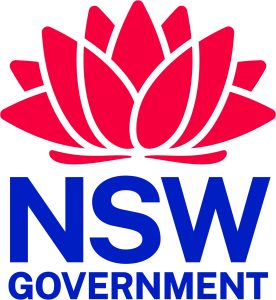

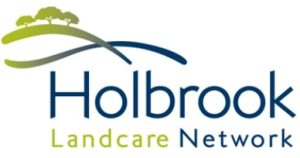
HLN is partnering with Local Land Services in the Murray region to deliver Prograze courses for producers in the 2022-2023 financial year. We are fortunate to have Phil Graham from Phil Graham Consulting delivering the courses, kicking off in September.
For more information, download the Prograze Flyer
To register your interest, Click Here
Are you a producer in the Riverina? Riverina LLS are also facilitating Prograze courses. For more information, contact Emma on 0411 626 181
